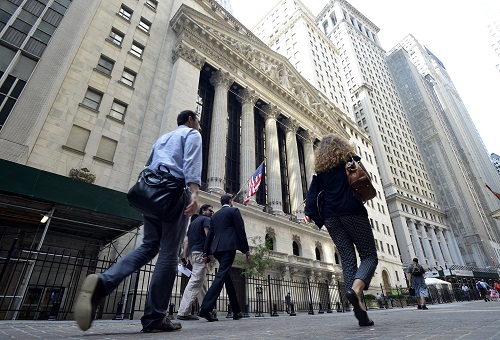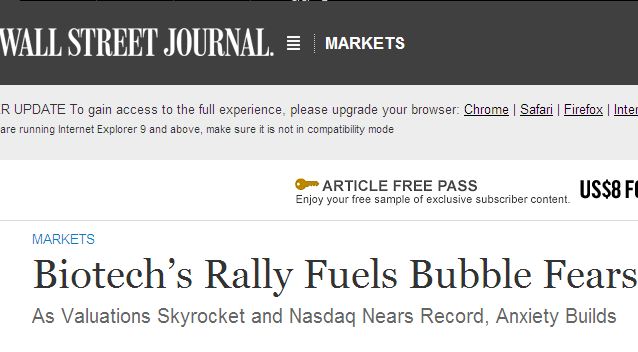 이미지 확대보기
이미지 확대보기월스트리트저널은 이날 신문과 온 라인 보도에서 “나스닥에 거품론 공포가 되살아났다”고 지적하면서 “이번에는 정보기술(IT)주가 아닌 바이오테크 관련주가 공포를 주도하고 있다”고 밝혔다. 바이오 주가가 너무 올라 대폭락을 야기할 수도 있다는 것이다. 이경우 바이오테크 뿐 아니라 나스닥 주가전체가 흔들릴 수 있다.
이 신문은 바이오테크 관련주의 주가지수인 바이오테크 인덱스가 2012년 이후 2년여 동안 무려 240%나 급등했다고 보도했다. 같은 기간 중 대형 IT주를 위주로 한 나스닥 100 기술지수의 82% 상승과 비교할 때 바이오테크 주의 상승은 매우 가파르다는 것이다.
2014 년 중 나스닥 기업 시장가치 증가분의 27%가 바이오테크 관련주에서 나왔다. 나스닥 시장에서 바이오테크 관련기업이 차지하는 비중이 13%선인 점을 감안할 때 27%의 기여는 놀라운 것이다.
바이오테크 인덱스는 올 들어서도 17% 내외 올랐다. 같은 기간 나스닥 100 기술지수의 1.4% 상승을 크게 상회하는 것이다.
월스트리트저널은 “바이오테크주가 급등하는 것은 기업들의 매출이 늘고 미국 식품의약국(FDA)의 신제품 승인이 늘어났기 때문”이라며 “신약개발에 실패하거나 자금이 고갈될 경우에는 IT버블 때와 같이 주가추락이 올 수도 있다”고 경고했다.
다음은 바이오테크주의 거품공포를 보도한 월스트리트 기사 전문
 이미지 확대보기
이미지 확대보기제목 Biotech’s Rally Fuels Bubble Fears
Nasdaq bubble fears are back.
But this time around, the biggest dangers may not involve technology stocks.
Instead, some investors are looking askance at biotechnology stocks, a sector that wasn’t nearly as developed when the Nasdaq Composite Index set its record close in 2000 of 5048.62.
The Nasdaq Biotech Index is up about 240% since the beginning of 2012. That dwarfs the 82% gain logged by the Nasdaq-100 tech index of the largest technology companies listed on the exchange operated by Nasdaq OMX Group Inc.
Giant biotech firms have surged in value: Both Gilead Sciences Inc., valued at $152 billion, and Amgen Inc., at $127 billion, have risen 40% over the past year. Biogen, valued at $108 billion, has climbed 47%. Celgene Corp., valued at $99 billion, is up 75%.
“If any part of the market reminds me of the go-go tech years, its biotech,” said Jack Ablin, chief investment officer at BMO Private Bank. “It’s an expensive sector.”
Companies developing biotech drugs?often upstarts that can be acquisition targets for larger pharmaceutical companies?comprise 13% of the Nasdaq Composite Index by market value but have accounted for 27% of the index’s gain over the past year, according to Birinyi Associates Inc. Biotech firms generally seek to develop medicines using living cells rather than chemicals.
Nasdaq biotech shares have advanced 27.4% over the past six months and roughly 17% so far this year, compared with gains of 7.3% for Nasdaq-100 Technology Sector Index shares over the past six months and 1.4% this year.
Behind the surge are heady earnings growth, more approvals from the Food and Drug Administration and investor enthusiasm for a range of new biotech drugs and potential treatments.
A Gilead Sciences laboratory in California. Shares of Gilead and some biotech peers have risen 40% or more in the past year. Photo: Bloomberg News .However, biotech stocks often are viewed as a gamble for investors: high-risk and high-reward propositions that can drop like a rock if a drug trial fails or funding runs out. Biotech shares have been hammered en masse several times, notably in 1990, 1993 and 2000.
“To us, shares of biotech companies find themselves entering bubble territory,” said Darren Pollock, portfolio manager at Cheviot Value Management. “We think investors are applying too high a success rate on biotech molecules.”
For all the sector’s recent successes, some see recent excitement for biotech shares as the latest sign that low interest rates are encouraging investor to take excessive risks.
If the economy slows, or rates start climbing, investors could turn more conservative and shy away from these companies, which often offer little in way of earnings.
A burst of initial public offerings of biotech companies over the past few years raises other concerns that these companies and selling insiders may be cashing in on investor excitement at the expense of public shareholders. That is why some investors are becoming wary.
“Some of these companies are attractive,” says Rob Arnott, founder and chairman of Research Affiliates, a firm that has developed strategies for products with $170 billion in assets around the globe. “But identifying which are cheap and which are froth is awfully difficult; it’s a safe bet a majority don’t deserve their current multiples.”
Biotech shares in the Nasdaq now trade at almost 50 times their earnings over the past year, compared with a price/earnings ratio of 27.5 for the overall Nasdaq Composite. Nasdaq biotech shares trade at 31.5 times their expected earnings over the next 12 months, above the 21 ratio for the overall Nasdaq market, according to FactSet Inc.
Just like Amazon.com Inc.,eBay Inc. and some other technology companies were growing companies with shares trading at sky-high valuations in 2000, some worry that today’s highflying biotech shares also are strong companies trading at prices that are too high. Celgene currently trades at a p/e ratio of 51.1. Biogen, Amgen and Gilead are at 36.6, 24.8 and 13.8, respectively.
To be sure, even those biotech valuations can’t hold a candle to the sky-high technology multiples of the Nasdaq record in 2000, when the index traded at a p/e well above 100 by some measures.
Biotech stocks focused on cancer therapies are notorious for their risks. One of the hottest such stocks over the past decade was Dendreon Corp., which sparked enthusiasm form a novel prostate-cancer drug, Provenge. The drug won approval from the FDA in April 2010 and was seen as the harbinger of a new era of treatments enabling the body’s immune system to fight cancer.
Dendreon shares topped $55 in 2010, putting the company’s market value at about $7.5 billion. But last November, Dendreon declared bankruptcy, weighed down by heavy debt and weak sales of Provenge.
Bullish biotech investors counter that typical signs of a bubble haven’t become apparent. In 2000, for example, biotechnology shares were soaring even though some companies were years away from even having a drug in trial. Today’s popular biotech shares are typically of companies that have drugs on the road toward approval.
At the same time, pharmaceutical companies are sitting on cash they are expected to use to make acquisitions. Pricing for oncology and other key drugs continues to rise, despite criticism. And some experts say true breakthroughs on cancer and some other challenging diseases may be near.
“You have to be somewhat optimistic to justify some of the valuations, but the excitement overall is justified,” said Dr. Nathan Fischel, who runs Dafna Capital Management LLC, a $170 million hedge fund in Los Angeles focused on biotech and medical devices.
“There are bubbles in some parts of the market but as a doctor, I feel like a kid in a toy store,” Dr. Fischel added. “There are so many exciting areas and there are good reasons investors are getting excited about biotechnology companies.”
김재희 기자 yoonsk828@
[알림] 본 기사는 투자판단의 참고용이며, 이를 근거로 한 투자손실에 대한 책임은 없습니다.











































